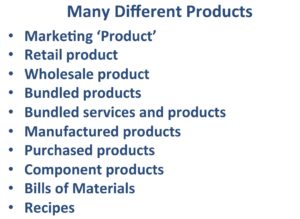Click here to view the blog post as a video.
What Do You Mean by ‘Product’?
When you go into an enterprise and you use the term, “product”, exactly what it means depends on who you’re talking to and in what department.
For example, if you go into the Marketing Department and talk to them about ‘product’, then they will think of ‘product’ in terms of the products that they market to the general public in marketing campaigns.
But if you go to the Sales Department, they will have a view of retail products that they sell to the general public and wholesale products that they sell to wholesale distributors. There will also be ‘bundled’ products where they put together different products into single ‘bundles’ for sale as one consolidated product to meet a specific market.

Then you can get ‘bundled’ products and services. Telecom companies are well known for this where the product is the phone and the service a calling plan for text or data, calls, etc.
When you go into the Production Department you will have the concept of ‘manufactured’ products, because that’s what they do, manufacture products to sell on, either as retail or wholesale products. Or they might manufacture products to be component parts in other products that they either manufacture themselves or buy in. You could then have ‘purchased’ products. Here they purchase in products which they might simply resell, or they purchase them in to make them component parts of larger products that they will sell. Then, in order to manage ‘component’ products, you will have the concept of component products and the structures around that, which might be traditional Bills of Material or something similar.
In companies like breweries and bakeries, you’ll have the concept of ‘recipes’, which will result in creating products that can be sold, but it will also consist of products that are bought in to become part of the products that are going to be sold.
Many ‘Product’ Management Systems
So, you’ll have very many different concepts of product, depending on who you talk to in an organisation. And for all the different concepts of product you’ll probably have as many different ‘product’ systems supporting that.

For example, you’re going to have the Marketing System with its concept of product. The Sales System with retail and wholesale products, an Inventory System to manage the stock of the products that are going to be sold by the organisation. A Logistics System to manage the logistics in the supply chain. Or maybe a standalone Dispatch System. A Manufacturing System, which will cover things like Bills of Materials, components structure, etc. Then, a Purchasing System to purchase in all of the products, raw materials, and other component products that are going to become part of what’s going to be sold.
Can They be Integrated?
The question is, can all of these different product views and product systems be integrated? Well, the answer is, ‘Yes‘. If you were to use the concepts that I have embedded in Multi-Dimensional Master Data Management, this can easily be done and integration can make them very powerful.
However, the real question is, ought they all to be integrated? The answer to that depends on whether of not such an integration would deliver real business benefits.
So, how do you decide this? If you look at product intelligence or product analysis, and ask whether or not the existing un-integrated systems can provide you with answers to key operational questions and delivering KPI information. Can your existing systems answer fundamental questions such as, “Which are our most profitable products? Which are our least profitable?”
Or “Is profitability the same across all customers or does profitability depend on customers? Does heavy marketing of a particular product effect profitability, and how do we reflect that? Are we able to reflect that in our current systems? Is profitability the same for all components?”
For example, if you swap in different component products to products you’re selling, and they’ve got different costs, can you up the price, is your pricing dynamic? Or are you going to cut into your profitability?
Multi-Dimensional MDM Master Class
I’m going to address all of these issues in much greater detail in the Master Class that I’m running on Multi-Dimensional MDM on the 25th and 26th of April, that’s the end of this month. It’s going to include the master entities of Party, Party Role, Party Relationship, Address, Address Use, and Location. Also Product, Product Structure, and Product Pricing. Then what’s often called the “Forgotten Master Entity”, Asset, Asset Structure, and Asset Location.
Now, this Master Class is valued at US$297, however, I’m doing it for the special price of only US$27 for all of my IMM and LinkedIn contacts. This is a special price for all of those people I have dealt with and are part of my network.
Click here to find out more and book your session.
Please book early because, in order to have a really good question and answer session in the masterclass, I’m limiting the numbers, so there is limited space, so please book as soon as you can.
You remember the “Forgotten Master Entity” of Asset? Well I’m going to be talking about that, in my next blog post on the business benefits of MDM in a couple of day’s time. So I look forward to connecting with you then.
In the meantime, Click here and book your session.
I’d love to see you at the masterclass. I guarantee you will have an excellent return on your investment in real quality information and powerful techniques. And if you feel you haven’t, I will refund your enrolment fee in full.
Spread The Love!
If you enjoyed this post, then please share it with a friend or colleague or leave a comment below. I would LOVE to hear from you.
